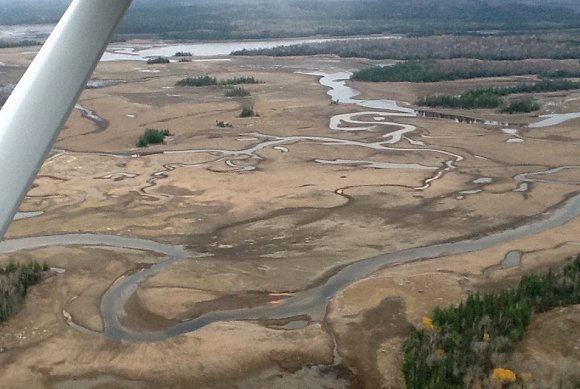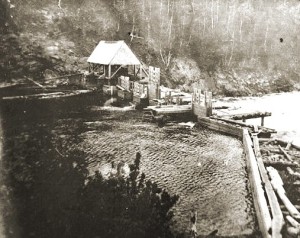| Having trouble reading this email? View it in your browser. |
|
December 22, 2015 |
 |
|
Preserving the “Sporting Camp Experience” |
|
|
|
Happy Holidays!
We wish you a happy and healthy holiday season and sincerely thank you for all your support and encouragement this past year.
This season, when you review your year-end contributions, we hope you will consider sending a gift and joining us in preserving Maine's sporting camp experience, the recreational opportunities camps provide, and their surrounding lands and waters.
With Sincere Thanks,
John Rust, President |
|
|

When a dam fails, scenery, recreation, fish & wildlife go with it.
|
|
The Whole "Dam" Problem
Dams have a major impact on sporting camps and recreational opportunities.
What should be done with old dams? Should they be removed or maintained? How and by whom? Big questions!
The Maine Sporting Camp Heritage Foundation's challenge is to create a standardized policy for dealing with dams, so that they may be improved, or removed, without undue hardship on all the affected parties - sporting camp owners, forest landowners, Maine's fish and wildlife biologists and the recreating public.

Maine's classic sporting camps are typically located on the shore of a lake whose water level is maintained by a dam. Virtually all of the dams were built a century ago to hold water for driving logs to the mills in early spring.
Now, over one hundred years later, logs are no longer transported via streams. These old dams remain unmaintained and present a troubling predicament for sporting camps, landowners and those living in downstream flood zones.
Two excellent examples of how difficult, and expensive, a problem that Maine's classic sporting camps now face are the dams at Second Roach Pond and Grand Lake Matagamon:
- Second Roach Pond: If any dam restoration were to have a successful outcome, this would be it. Unfortunately, despite great intentions, excellent funding and professional staffing, rebuilding the dam turned into a disaster - very costly to the environment and the dam's owner.
- Grand Lake Matagamon: Many of Maine's 100 year old sporting camps are situated on lakes having much more complex dams than that at Second Roach Pond - having flow control gates and fish ladders. The Matagamon dam situation illustrates how expensive a repair project might be. The photo above is not of a tidewater mud flat - It was of a beautiful lake.
Continue Reading... "The Whole Dam Problem"...
|
|
|
How Many Sporting Camps in Maine?
Such simple questions - How many are there? Where are they located? Which ones are able to survive well into the future? Which ones are in danger of being lost? What do they need for resources and assistance?
These questions have been asked many times, yet no one has the answers! Not the State agencies that issue the business permits, building permits and drinking water permits! Not Maine's tourism and economic development agencies.
Therein lies a major problem. One that must be solved before effective action can be taken to strengthen the entire industry or to preserve individual camps.
The Maine Sporting Camp Heritage Foundation has begun to create a database containing all that information. This task involves a vast amount of research, and involves several State agencies, major forest landowners, other nonprofits and the sporting camp industry. READ MORE...
|
|
|
New Board Members
|
|
The Maine Sporting Camp Heritage Foundation is currently meeting with persons (and groups) who might be interested in supporting our mission by joining our Board of Directors.
Perhaps you are interested, or know of someone who might be, and would like to hear more. We would love to meet with you and fill you in on all the possible ways you might get involved. Please contact John Rust at (207) 337-5858 or send an Email to us at info@sportingcampfoundation.org.
|
Traditional Cabin Style |
|
|
Coming Up
Sporting Camps or Sports Camps? A Branding Challenge
In the late 1800's Maine sporting camps were widely known as major destinations for those hoping to escape the heat, crowding and pollution of cities like Boston, Hartford, New York, Philadelphia and Washington. Outdoor and sporting exhibitions were common, even in New York's Central Park. That awareness is gone today. Traditional sportsmen and women, hunting and fishing enthusiasts, still have a clear understanding of the term "sporting camp," as does Maine's conservation community who are focused on the north woods environment. But try describing a "sporting camp" to a vacationer "from away" and you find their first thought is "sports," as in "soccer camp" for kids! Coming up are ways to increase the sporting camp industry's brand awareness, and for developing new services to broaden the customer base.
Alien Infestation?
Most of Maine's sporting camps enjoy the sights, sounds and scents of our northern spruce-fir forests. But trouble is on the horizon. It comes from Mother Nature in the form of the spruce budworm, whose population is now in a rapidly growing stage of their cycle. Budworms are actually native to Maine. They feed on fir and spruce needles. In large enough numbers, this will kill a tree. Worse, when budworm populations grow very high they can kill thousands of acres of trees. How has this affected sporting camps in the past, and is there anything that might be done to minimize that in the future? Look for more info in a future newsletter. |
|
|
|
| Photo Credits: Matagamon Lake pics provided by Mt Chase Lodge |
|